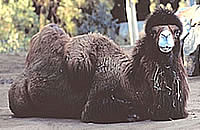At Which Of The Placemarked Locations In The Animals Folder Do You Find Camels?
Camels are even-toed ungulates, pregnant 'hoofed animals'. There are several groups of ungulate mammals whose weight is distributed about every bit by the tertiary and fourth toes equally they move around. Camels are native to the dry desert areas of western Asia and cardinal and east Asia. The name camel comes from the Greek kámēlos from the Hebrew 'gamal' or Standard arabic 'Jamal'.
There are 2 primary species of camel, the Dromedary Camel sometimes called the Arabian Camel which has a single hump and are warmer climate dwellers and the Bactrian Camel which has 2 humps and are rugged cold-climate camels.
Fossil evidence indicates that the ancestors of modern camels evolved in North America during the Palaeogene period (a menstruation of geologic time that lasting 42 1000000 years and is a time when mammals evolved) and after spread to Asia.
There are almost 14 1000000 Dromedary camels alive today that are domesticated animals, more often than not living in Somalia, Sudan, Islamic republic of mauritania and nearby countries.
The Bactrian camel in one case had an enormous range, nonetheless, it is now reduced to an estimated one.4 1000000 animals, mostly domesticated. It is idea that there are about 1000 wild Bactrian camels in the Gobi Desert in China and Mongolia.
Humans start domesticated camels betwixt 3,500 – 3,000 years ago. The Dromedary camel and the Bactrian camel are both still used for milk (which is more nutritious than cows milk), meat and as beasts of burden (an animate being that is kept past humans and trained every bit a working creature), the Dromedary camel in western Asia and the Bactrian camel further to the north and eastward in key Asia.
Camel Characteristics

Camels are camelids, members of the biological family Camelidae, the but living family in the suborder Tylopoda. Camels tend to exist big and are strictly herbivorous. Camels differ from ruminants in several ways.
Camels take a 3-chambered rather than a iv-chambered digestive tract. They have an upper lip that is split in two with each part separately mobile, Camels also have an isolated incisor in the upper jaw. The cherry-red blood cells in camels are oval shaped, different those of other mammals, which are circular. This is to facilitate their flow in a dehydrated state. These cells are too more stable in order to withstand loftier osmotic variation (the improvidence of water through a cell wall or membrane) without rupturing when drinking big amounts of h2o.
A fully grown adult camel stands 1.85 metres (6 feet) at the shoulder and 2.xv metres (7 anxiety) at the hump. Camels can run up to 65 kilometres per hour (40 miles per 60 minutes) in short bursts and sustain speeds of up to twoscore kilometres per hr (25 miles per 60 minutes).
The average life span of a camel is 30 to lx years.
The term camel is also used more broadly to describe whatever of the six camel-similar creatures in the family unit Camelidae. The 2 truthful camels and the four South American camelids, Llama, Alpaca, Guanaco and Vicuña.

Camels are well known for their humps. A camels hump or humps enhance most 30 inches out of its trunk. Camels exercise non, however, store water in their humps equally commonly believed, though they do serve this purpose through roundabout means. Camels humps are a reservoir of fatty tissue, while h2o is stored in their blood.
However, when this tissue is metabolised, information technology is not merely a source of energy, just yields through reaction with oxygen. This allows camels to survive without water for about two weeks and without food for up to a month.
The kidneys of a camel are very efficient. Urine comes out as a thick syrup and their faeces are and then dry that information technology can fuel fires.
Camels are able to withstand changes in body temperature and water content that would kill about other animals. Their temperature ranges from 34°C (93°F) at dark up to 41°C (106°F) in the day and just higher up this threshold will they brainstorm to sweat. This allows them to preserve nigh v litres of water a solar day. Camels can withstand at to the lowest degree 25% weight loss due to sweating.
A characteristic of their nostrils is that a large amount of water vapour when they exhale is trapped and returned to their body fluids, thereby reducing the amount of water lost through respiration.
A camels thick coat reflects sunlight. A shaved camel has to sweat fifty% more to avoid overheating. Information technology also insulates them from the intense oestrus that radiates from hot desert sand. Their long legs help by keeping them further from the hot basis. Camels have tough feet so that they can endure the scorching desert sands. Camels accept been known to swim if given the chance.
A camels oral cavity is very sturdy and they are able to chew thorny desert plants. Long eyelashes and ear hairs, together with closeable nostrils, form an effective barrier confronting sand. Camels pace (moving both legs on one side at the same time) and their widened feet assist them move without sinking into the sand.
All fellow member species of the Camelids are known to have a highly unusual immune system, where function of the antibody repertoire is composed of immunoglobulins without light chain. Whether and how this contributes to their resistance to harsh environments is currently unknown.
Check out more than animals that begin with the letter C
Source: https://animalcorner.org/animals/camels/
Posted by: cappssomay1959.blogspot.com

0 Response to "At Which Of The Placemarked Locations In The Animals Folder Do You Find Camels?"
Post a Comment